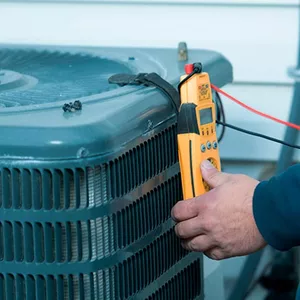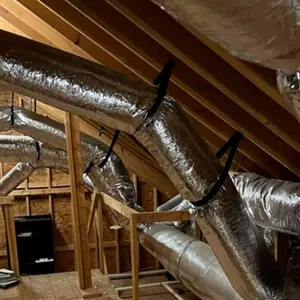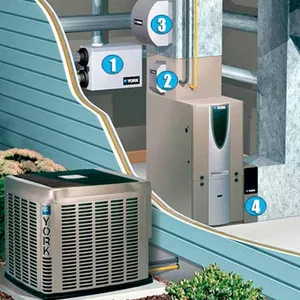Many Chicago homeowners upgrade their heating systems alongside other components such as air conditioners, ductwork, humidifiers, or media filters. Combining these installations into one coordinated project improves energy efficiency, airflow balance, and indoor air quality—while reducing overall labor time and inspection visits. A properly designed furnace combo installation ensures that every component, from the blower motor to the thermostat, operates in sync for comfort and long-term reliability.
When to Consider a Furnace Combo Installation
Combining installations makes sense when existing systems are aging or mismatched. For example, pairing a new high-efficiency furnace with an older air conditioner can lead to uneven performance and airflow imbalance. Likewise, installing new ductwork or air filtration at the same time as the furnace ensures that airflow, static pressure, and return sizing are optimized from the start. Coordinating these systems under one permit also simplifies scheduling and inspection under Chicago mechanical code.
Furnace and AC Installation (Same Project)
A furnace and AC installation completed as a single project guarantees system compatibility. The evaporator coil, blower motor, and control board must share compatible airflow and staging logic. Matching the furnace’s CFM output to the air conditioning coil size keeps temperature rise and cooling efficiency within manufacturer limits. Refrigerant lines are re-routed or replaced to match new coil configurations and refrigerant type (R-410A or R-32). Electric circuits are sized correctly for both heating and cooling loads, ensuring balanced operation across seasons.
Professional installers verify airflow with static pressure testing, confirm condensate drainage for the coil, and calibrate thermostats for both heat and cool modes. Most dual installations in Chicago complete within one to two workdays depending on accessibility and permitting.
Furnace and Ductwork Installation
When existing ducts are undersized or leaking, combining furnace and ductwork installation provides the best performance improvement. Technicians calculate the home’s required CFM, design trunk and branch sizes, and install sealed sheet-metal runs with mastic or tape rated for static pressure. Balanced supply and return design prevents hot and cold spots while maintaining even static pressure across the system.
This type of combo project may include adding return grilles, upsizing plenums, and sealing joints to achieve 0.1–0.2 inches w.c. per branch. Replacing the ductwork along with the furnace also ensures that airflow matches modern blower speeds and variable-speed motor profiles for quieter operation and improved efficiency.
Furnace with Whole-House Humidifier
Installing a whole-house humidifier alongside a new furnace protects both comfort and system longevity. Proper humidity levels help heat transfer across the heat exchanger and prevent static buildup in dry Chicago winters. Technicians connect the humidifier to the furnace’s control circuit, ensuring it operates only during heating cycles. Drain lines and water supply connections are installed to prevent leaks and comply with plumbing code.
By integrating humidity control at installation, the home benefits from balanced comfort and reduced wear on wood floors, furniture, and skin. The system’s automatic controls can be tied into smart thermostats for set-and-forget operation.
Furnace with Media or HEPA Filter
Adding a media or HEPA filter during furnace installation enhances indoor air quality and reduces dust buildup inside the cabinet and ducts. These filters have higher surface area and longer service life than standard one-inch filters, lowering maintenance frequency. Installers add a sealed filter rack to the return plenum, ensuring no bypass air reduces filtration effectiveness.
High-efficiency filters also protect the blower wheel and heat exchanger from dust accumulation, maintaining steady airflow and temperature rise. A properly sealed filter system supports healthy indoor air and longer furnace lifespan without restricting CFM below safe thresholds.
Key Benefits of Combined Furnace Installation Projects
- Matched airflow and control systems for higher efficiency
- Reduced total labor and inspection scheduling
- Balanced static pressure and improved comfort delivery
- Optimized indoor air quality through upgraded filtration
- Integrated humidity and comfort control under one setup
Common Components Included in Furnace Combo Installation
- New furnace matched to coil or duct design
- Evaporator coil and refrigerant line installation
- Sealed sheet-metal transitions and duct adjustments
- Media filter rack or humidifier integration
- Full system commissioning with airflow and temperature verification
Professional Furnace Combo Installation in Chicago
Whether combining a furnace with new ductwork, an air conditioner, or a humidifier, coordinating the installation as a single project ensures that every system component performs efficiently together. Licensed Chicago HVAC technicians follow all mechanical and electrical code standards, balance airflow, and document static pressure and temperature rise readings at handoff. The result is a quieter, more efficient, and longer-lasting comfort system customized to your home’s design and heating load.











